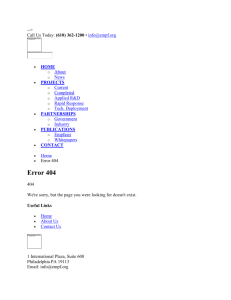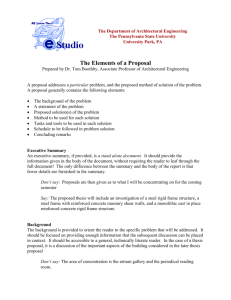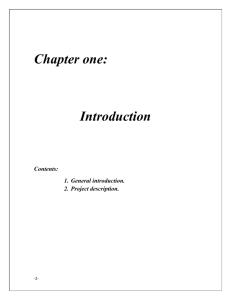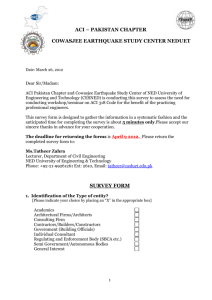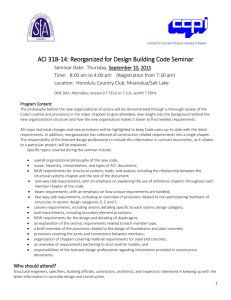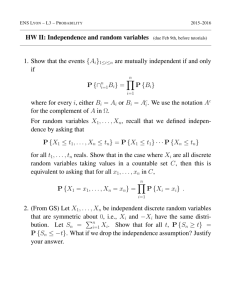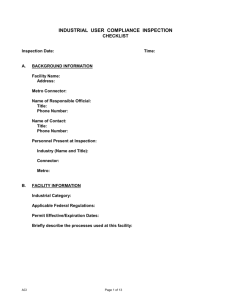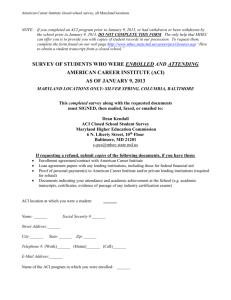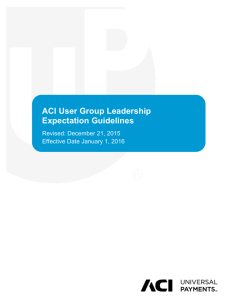Reinforced Concrete Design Lecture 2
advertisement
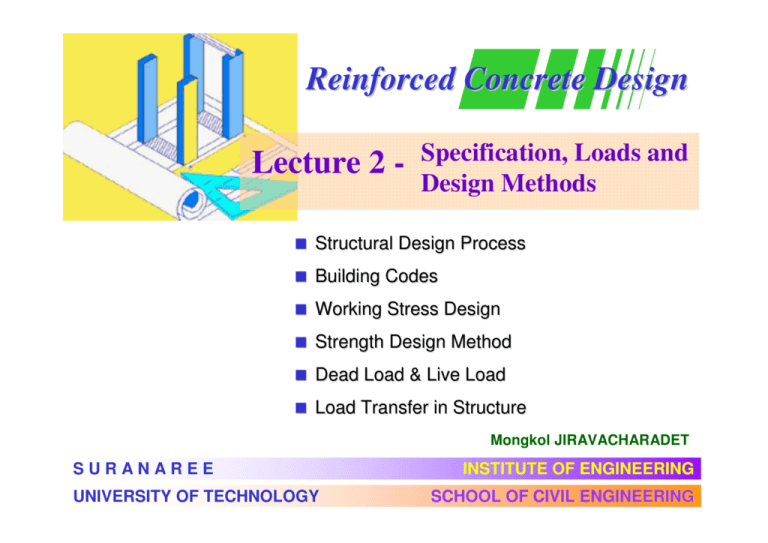
Reinforced Concrete Design
Lecture 2 -
Specification, Loads and
Design Methods
Structural Design Process
Building Codes
Working Stress Design
Strength Design Method
Dead Load & Live Load
Load Transfer in Structure
Mongkol JIRAVACHARADET
SURANAREE
UNIVERSITY OF TECHNOLOGY
INSTITUTE OF ENGINEERING
SCHOOL OF CIVIL ENGINEERING
Design Process
Architectural
Functional Plans
Final Design
& Detailing
Select Structural
System
OK
Trial Sections,
Assume Selfweight
Analysis for internal
forces in member
Redesign
Acceptable?
NG
Design Loop
Member Design
Specifications
Developed by organizations such as AISC, ACI
ASCE, and EIT
Recommendations of good practice based on
the accepted body of knowledge
NOT legally enforceable
Organizations
EIT = Engineering Institute of Thailand
ASCE = American Society of Civil Engineers
AASHTO = American Association of State Highway
and Transportation Officials
UBC = Uniform Building Code
BOCA = Building Officials & Code Administrators
ACI = American Concrete Institute
Building Codes
Minimum requirements to protect the public
- ... 2522
- - Design Loads
Dead Loads - stationary loads of constant
magnitude
Live Loads - moving loads or loads that vary
in magnitude
(Dead Load)
Caused by the weight of structure
Include both the load bearing and non-load
bearing elements in a structure
Generally can be estimated with reasonable
certainty
()*(+,
!"
#$%&'
(, * !""#$"%
!""#$()"
kg/m3
2,400
2,320
500-1,200
7,850
kg/m2
14
50
5
10-30
5
180-360
100-200
Load from Precast Concrete Slab
Floor load = w kg/sq.m
S
Tributary area = 0.5SL sq.m
Load on beam = 0.5wSL kg/m
L
Example: CPAC Hollow Core Slab HC100
100 mm
600 mm
SLAB WEIGHT
296
KG/M2
PC WIRE
6∅4
MM.
SPAN
4
M.
LIVE LOAD
300
KG/M2
w = ? kg/m
L : Beam span
4m
- (Live Load)
Floor Loads
Snow and Ice: 50 - 200 kg/sq.m.
Traffic Load & Pedestrian Load for Bridges
Impact Loads
Lateral Loads: Wind & Earthquake
-0
6 (.. 2527) ..
. .. 2522
!"#$"%&
(1) (2) (3) !
"#
(4) %&" '%&"()
) %# %*
+,-.,
(5) !
0
(6) () 2-)3 4",%&" '%&"()
2-)3
#
"-
"-
%*
(,) & + )4
-,
) %#
!
%*0
'#"(#)*'#+
(kg/m2)
30
100
150
200
250
300
300
-0 (*)
6 (.. 2527) ..
. .. 2522
!"#$"%&
(7) () -
7*)# # 8
7*)# 4
(##
9:&39
3
(,) & + )4
-,
2-)3 #
"-
"-
%*
(8) () -
<
--082=3 >93 #
-#3 :
%*
(,) & + )4
-,
-
7*)# 7*)# # 8
# %*#
(9) :,##
(10) 9:&74
'#"(#)*'#+
(kg/m2)
400
500
500
500
600
800
Wind Loads
*
0!1'23103(*#43# 53
65
q = 0 .5 ρ V
2
ASCE 7-98
q = 0.00483 K V
7 q = stagnation pressure 3# (./.2)
V = basic wind speed 8 7)#9#
3!: 10 $ (./=.)
K = >$?!*'
!:7#$"+ 10 $
2
$ ..
. .. 2522
WIND DIRECTION
"4
10
10 < h < 20
20 < h < 40
#
"4
40
'#"( (./$..)
50
80
120
160
30 m
Leeward side
!:
($)
Windward
side
20 m
Step wind loading
10 m
0m
19 !"#$
" %& "$'( ''('"$ !'"()
(1) ''/0
(2) 7 '&''/0
(3) '&''/0
(4) $'&''/0
(5) '&''/0
(6) '&''/0
(7) '&''/0
(8) &#''&''/0 "$
0
0
0
10
20
30
40
50
$8 ) %$ ) %$ $%' $%' 8989:;<= >&= 9
%"$ &'#"= &"= 9'
%&"#$
"% aci 318
Building Code Requirements for
Structural Concrete (ACI318-XX)
and Commentary (ACI318R-XX)
Early 1900s: WSD was mainly used.
ACI 318-56: USD was first introduced.
ACI 318-63: Treated WSD and USD on equal basis.
ACI 318-71: Based entirely on strength approach (USD)
WSD was small part called Alternate Design
Method (ADM).
ACI 318-77: ADM moved to Appendix A
USD was called Strength Design Method.
aci 318
Building Code Requirements for
Structural Concrete (ACI318-XX)
and Commentary (ACI318R-XX)
ACI 318-83: ADM moved to Appendix B
ACI 318-89: ADM back to Appendix A
ACI 318-95: Unified Design was introduced in Appendix B
ACI 318-99: Limit State at Failure Approach was introduced
ACI 318-02: Change load factor to 1.2DL + 1.6LL
ACI 318-05
1*2345 (Working Stress Design : WSD)
ACI: Alternate Design Method
- Design under service load condition
- Apply F.S. to strength of materials for
allowable stress level Fa
Stress from
service load
Concrete:
Allowable stress
Fa
Fa = 0.45f’c (ACI and ".),
= 0.375 f’c (...
Steel:
Fa = 0.50Fy
"#
2522)
Disadvantages of WSD:
- Not account for the variability of the resistances
and loads
- Lack of any knowledge of the level of safty
F.S. is not known explicitly
- Inability to deal with groups of loads where one load
increases at a rate different from that of the others.
1? (Strength Design Method : SDM)
#*+ ,-. = Ultimate Stress Design (USD)
- Factored load condition = Structure is about to fail
(Ultimate load = /,
Design Strength
( -. )
≥
Required Strength (U)
- Apply F.S. in design via:
- Load factors (> 1.0)
- Strength reduction factors (< 1.0)
Load Factors
Required Strength (U)
= Load Factors × Service load
= Factored Load
= Dead Load Factor = 1.4
Live Load Factor
= 1.7
Factored Load
= 1.4 DL + 1.7 LL
Service Load
= DL + LL
Factored Load Combinations
General:
U = 1.4 DL + 1.7 LL
Wind Load:
U = 0.75(1.4 DL + 1.7 LL+1.7W)
U = 1.05DL + 1.275W
Lateral Earth Pressure:
U = 1.4 DL + 1.7 LL+1.7H
U = 0.9DL + 1.7H
Strength Reduction Factors
Nominal Strength (N) = Strength of a member calculated using
Strength Design Method.
Strength Reduction Factor = factor that account for
(1) Variations in material strengths and dimensions
(2) Inaccuracies in the design equations
(3) Degree of ductility and required reliability of member
(4) Importance of member in the structure
Strength reduction factor (φ
φ) :
Bending
φ = 0.90
Shear and Torsion
φ = 0.85
Compression
φ = 0.70 or 0.75
Load Transfer in Structure
Snow, Rain, Wind
and Construction load
Floor loads
Roof + Dead load
Slab + Dead load
Beam + Dead load
Wind load
Earthquake
Column + Dead load
Soil
Foundation
Wall load
